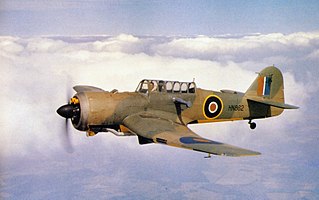
The Airspeed AS.57 Ambassador is a British twin piston-engined airliner that was designed and produced by the British aircraft manufacturer Airspeed Ltd. It was one of the first postwar airliners to be produced.

The Vickers VC10 is a mid-sized, narrow-body long-range British jet airliner designed and built by Vickers-Armstrongs (Aircraft) Ltd and first flown at Brooklands, Surrey, in 1962. The VC10 is often compared to the larger Soviet Ilyushin Il-62, the two types being the only airliners to use a rear-engined quad layout, while the smaller business jet Lockheed JetStar also has this engine arrangement.

The Miles M.14 Magister is a two-seat monoplane basic trainer aircraft designed and built by the British aircraft manufacturer Miles Aircraft. It was affectionately known as the Maggie. It was authorised to perform aerobatics.

The Miles M.25 Martinet was a target tug aircraft of the Royal Air Force (RAF) and Fleet Air Arm (FAA) that was in service during the Second World War. It was the first British aircraft to be designed specifically for target towing.

The Miles M.9 Master was a British two-seat monoplane advanced trainer designed and built by aviation company Miles Aircraft Ltd. It was inducted in large numbers into both the Royal Air Force (RAF) and Fleet Air Arm (FAA) during the Second World War.

The de Havilland DH.89 Dragon Rapide is a 1930s short-haul biplane airliner developed and produced by British aircraft company de Havilland. Capable of accommodating 6–8 passengers, it proved an economical and durable craft, despite its outdated plywood construction.

The de Havilland Express, also known as the de Havilland D.H.86, was a four-engined passenger aircraft manufactured by the de Havilland Aircraft Company between 1934 and 1937.

The Avro York was a British transport aircraft developed by Avro during the Second World War. The design was derived from the Avro Lancaster heavy bomber, several sections of the York and Lancaster being identical. Due to the importance of Lancaster production, York output proceeded slowly until 1944, after which a higher priority was placed upon transport aircraft.

The Handley Page HP.81 Hermes was a civilian airliner designed and produced by the British aircraft manufacturer Handley Page.

The Vickers VC.1 Viking is a British twin-engine short-range airliner derived from the Vickers Wellington bomber and built by Vickers-Armstrongs Limited at Brooklands near Weybridge in Surrey. After the Second World War, the Viking was an important airliner with British airlines, pending the development of turboprop aircraft like the Viscount. An experimental airframe was fitted with Rolls-Royce Nene turbojets and first flown in 1948 as the world's first pure jet transport aircraft. Military developments were the Vickers Valetta and the Vickers Varsity.

The Handley Page H.P.42 and H.P.45 were four-engine biplane airliners designed and manufactured by British aviation company Handley Page, based in Radlett, Hertfordshire. They held the distinction of being the largest airliners in regular use in the world on the type's introduction in 1931.

The Handley Page HPR.7 Dart Herald is a British turboprop passenger aircraft, designed in the 1950s as a DC-3 replacement, but only entering service in the 1960s by which time it faced stiff competition from Fokker and Avro. Sales were disappointing, contributing in part to the demise of Handley Page in 1970.

The de Havilland DH.91 Albatross was a four-engined British transport aircraft of the 1930s manufactured by de Havilland Aircraft Company Limited. Seven aircraft were built between 1938 and 1939.

The de Havilland DH.84 Dragon is a successful small commercial aircraft that was designed and built by the de Havilland company.

The Miles M.38 Messenger is a British four-seat liaison and private owner aircraft built by Miles Aircraft.

The Bristol Ten-seater and Bristol Brandon were British single-engine biplane transport aircraft built by the Bristol Aeroplane Company in the early 1920s. Only three were built, two of which were used as civil transports and one of which served with the Royal Air Force.

The Miles M.3 Falcon is a 1930s British three/four-seat cabin monoplane aircraft designed by Miles Aircraft Limited.

The Miles M.4A Merlin was a 1930s British five-seat cabin monoplane built by Miles Aircraft Limited.

The Miles M.7 Nighthawk was a 1930s British training and communications monoplane designed by Miles Aircraft Limited.

The Miles M.65 Gemini was a British twin-engined four-seat touring aircraft designed and built by Miles Aircraft at Woodley Aerodrome. It was the last Miles aircraft to be produced in quantity.























